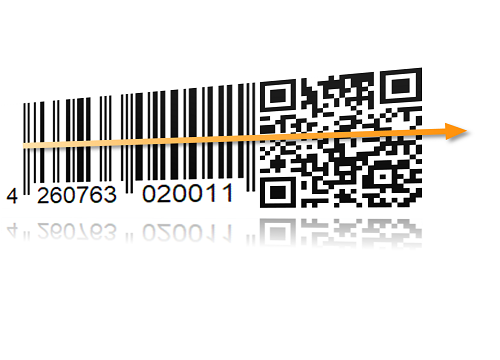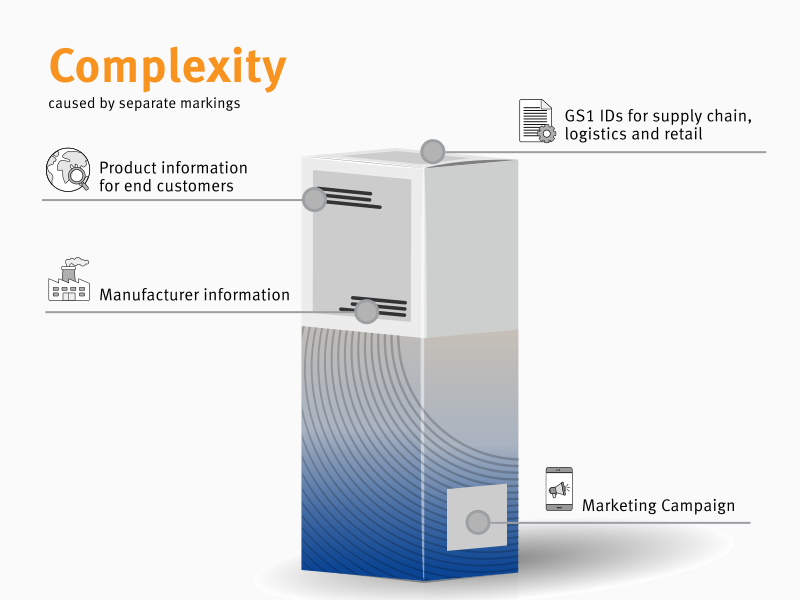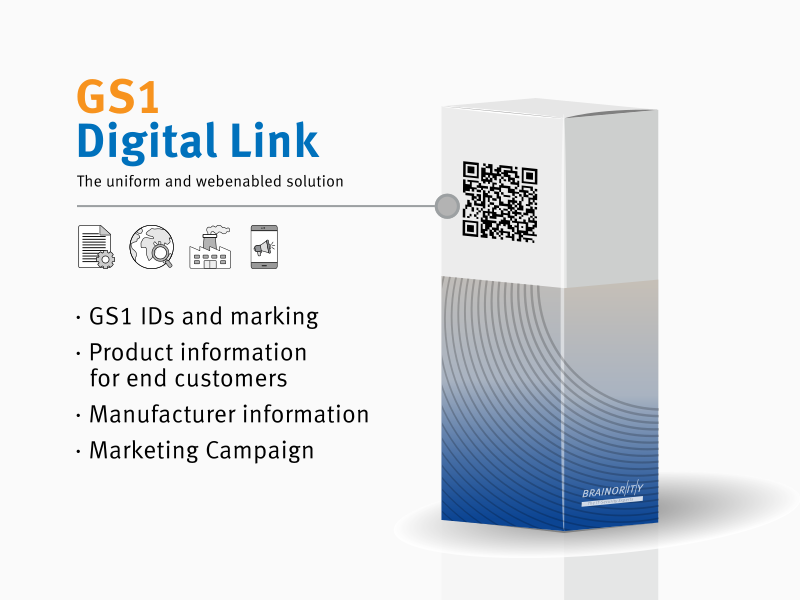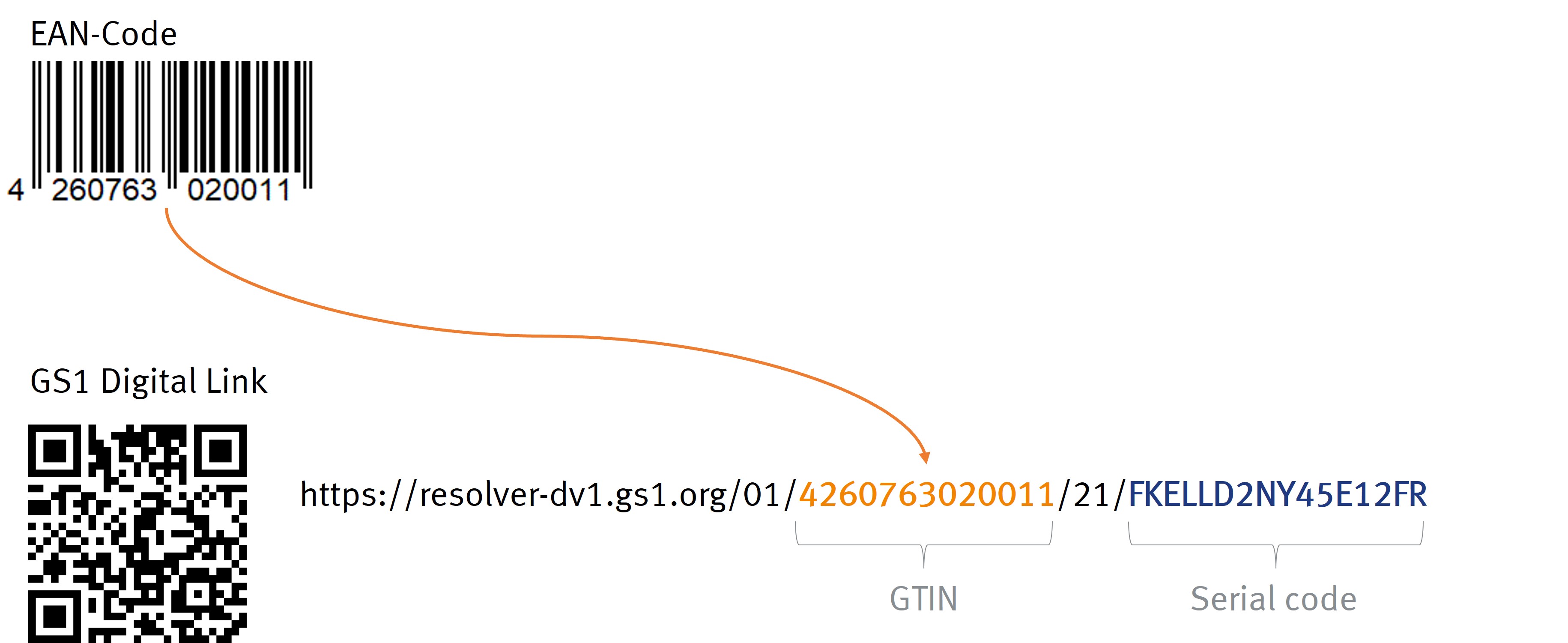The new digital solution for product identification according to GS1 standard
GS1 Digital Link
With the new GS1 Digital Link standard, completely new possibilities arise from pure product labeling due to the web capability.
The link between the physical and the digital world

So far, the EAN barcode has been used for product identification, which is now being extended by GS1 with a new standard, the GS1 Digital Link. The one-dimensional barcode only contains the EAN (GTIN) and is therefore only used for product identification only. The GS1 Digital Link complements this concept by embedding it in a web-enabled link. Via this link, each physical product is connected to a digital twin that contains all product information. The GS1 Digital Link thus links the physical with the digital world, so that is the basis for the exchange of information between manufacturer, retail partner and end customer. What's important in this context: all previously used product information, such as GTIN and other characteristics, will continue to be valid.
SecIdent is an innovative solution for product and counterfeit protection. With the help of serialization, unique and counterfeit-proof serial codes are generated for each product item. Each product is thus individually identifiable and offers effective protection against product counterfeiting. SecIdent also provides additional functionalities such as gray market analyses and market intelligence via this identification function. Embedding the serial code in a QR code allows real-time verification without the need for special hardware or software and can be done very easily and quickly, e.g. via a smartphone. Thus, the anti-counterfeiting software can be used completely independently of the GS1 Digital Link. However, because the implementations of the GS1 Digital Link and SecIdent are based on a similar technical concept, they can be effectively combined. On the product packaging, only one element (QR code) is required for product identification and counterfeit protection.
The example shows the comparison between the previous solution with unrelated information (left) and the new integration of all information in the GS1 Digital Link (right).


How to implement the GS1 Digital Link with SecIdent?
In contrast to the EAN barcode, the GS1 Digital Link can be used to map many other data contents in addition to the GTIN. For example, the product here has the GTIN (4260763020011). Additional parameters with diverse information for various target groups can also be indicated and accessed online.

Using identifiers, such as /01/ for the GTIN, the product information is easy to identify for application systems and can be expanded almost limitless. This means that the unique serial code (FKELLD2NY45E12FR) can also be integrated for counterfeit protection.
An automatic forwarding is available on the GS1 server, so that verifications can be forwarded via the Internet to the specified website. In our case, the homepage of the product is stored, which simultaneously validates the serial code for authenticity in the background.

Depending on which device accesses the code, different data is provided. This ensures that the right information is provided for logistics partners, retailers and end customers.
Why is the implementation with SecIdent a good idea?
SecIdent includes the required features right from the start and thus offers the ideal and proven basis for implementing the new GS1 Digital Link concept in practice. As an established system, SecIdent offers additional functionalities beyond pure identification, such as counterfeit protection, gray market analysis, market intelligence, geolocation, customer communication and much more. As a serialization system, SecIdent assigns a unique and tamper-proof serial code to each individual product copy. Using this unique identification, the manufacturer can provide additional information, for example:
- So-called cross-selling offers, i.e. suitable additional products
- Additional product information, such as ingredients, nutritional values or recipes
- Registration for warranty offers
- Product information
- Instructions
- Loyalty and loyalty programs
- Traceability
- Product registrations
This not only builds customer loyalty, but the brand is perceived favorably by the customer with this product experience. At the same time, the manufacturer receives evaluable data on demand and can use it to better determine future lot sizes and trends.
Advantages:
- All information is bundled in one code, so only one code needs to be applied to each package
- No interruptions in the process
- Reliable product information available to supply chain partners (B2B) and customers (B2C) at all times
- Unique serialization for specific customer offerings
- Customer interaction options, such as loyalty and loyalty programs and use as an effective marketing tool
- Anti-counterfeiting with unique serial codes
- Gray market detection through geolocation
- Evaluations through localization of products (market intelligence)
- Digitization
- Fulfillment of customer expectations
- Multilinguality